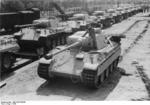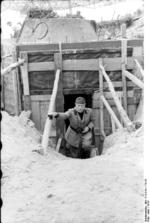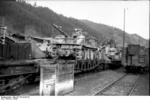PzKpfw V Panther
| Country | Germany |
| Primary Role | Medium Tank |
Contributor: C. Peter Chen
ww2dbaseThe PzKpfw V (Panzer V) Panther, or SdKfz. 171, medium tanks were designed to replace the Panzer III and Panzer IV tanks. Because the appearance of the Russian T-34 tanks on the battlefield during the design stage, the ability to counter these new weapons was also added as a requirement. When Daimler-Benz and Maschinenfabrik Augsburg-Nürnberg AG (MAN) delivered each of their potential designs in Apr 1942, the Daimler-Benz design had a stunning resemblance to the T-34 design, while the MAN design was more so a natural progression of German armor evolutionary path. Adolf Hitler showed preference toward the Daimler-Benz design, but ultimately MAN's design was selected due to the fact that the use of existing turret designs meant it would be much quicker to get the MAN design into production. Compared to the Daimler-Benz design, the MAN design also had better suspension, wider tracks, and a bigger fuel tank. The armor for this design consisted of 80-millimeter homogeneous steel frontal hull plate sloped back at 55 degrees from the vertical, which would be difficult for most Allied weapons to penetrate. The turret was, as noted earlier, typical German design, but the front was covered by 100-millimeter of cast steel which was also shaped to deflect shells (which, in the beginning, actually made certain shots worse when they are deflected downwards into the crew compartment). The main weapon was to be the 7.5-centimeter Rheinmetall-Borsig KwK 42 L/70 gun with 79 rounds of ammunition; the gun's long barrel and the large propellant charge used made the Panther guns some of the most lethal tank guns among contemporaries. In fact, Panther guns had better penetration capabilities against enemy armor than those of Tiger I heavy tanks in most circumstances. Apart from the overhanging gun and the sloping armor, most other characteristics were similar to conventional German tanks. The design called for a crew of five, which consisted of a commander, a driver, a radio operator/bow machine gunner, a gunner, and a loader.
ww2dbaseProduction of the Panzer V Panther medium tanks began in Sep 1942, but numbers were extremely limited due to delays caused by lack of specialized machine tools. By Dec 1942, production was expanded to factories of Daimler-Benz, Maschinenfabrik Niedersachsen-Hannover, and Henschel & Sohn. In 1943, the factories were producing on average 148 Panzer V Panther tanks per month.
ww2dbaseAlthough Panzer V Panther medium tanks were designed as a replacement to Panzer III and Panzer IV tanks, ultimately they served on the front lines together. They first saw action at the Battle of Kursk in Jul 1943, where design flaws with suspension systems breaking down and engines overheating and catching on fire were discovered. At that battle, more Panther tanks became casualties due to mechanical problems than those damaged in combat. German armor commander Heinz Guderian later noted that early model Panther tanks "burnt too easily, the fuel and oil systems were insufficiently protected, and the crews were lost due to lack of training", though he also acknowledged that the frontal armor and the weapons were good. Many of the mechanical problems were corrected by late 1943. In Jun 1944, about half of the German front line tank strength was made up of Panther tanks.
ww2dbaseDesign work on the planned successor Panther II began in Feb 1943. The project stressed on the interchangeability of parts with the Tiger II heavy tank for efficiency in terms of production and field logistics. The project was never completed; only one prototype was built.
ww2dbaseThe Russian response to the appearance of these new German tanks was swift as many of the tank guns, including the 76.2-millimeter guns of T-34 tanks, were ineffective against Panther tanks' thick frontal armor, while Panther tanks' guns could penetrate T-34 tanks' armor from all angles. Upgraded variant T-34-85 and new anti-tank vehicles such as SU-85 and SU-100 were soon placed in production to counter the German Panzer V Panther tanks.
ww2dbaseThe Western Allies did not encounter Panther tanks on the field until early 1944 when these new tanks were deployed at Anzio, Italy. The production of these tanks was studied closely in preparation for the cross-Channel invasion that was to be known was Operation Overlord. The American response was to produce a variant of M4 Sherman tanks with larger guns and various tank destroyers to deal with the Panther tanks, though field experience indicated that the Panther tanks' frontal armor was still difficult to penetrate. The British fielded the modified Sherman Firefly tanks and towed 17-pounder guns in Normandy, France against these new German tanks.
ww2dbaseOn 27 Feb 1944, Hitler ordered that the Roman numeral "V" be deleted from the designation.
ww2dbaseIn 1944, German factories were producing on average of 315 Panther medium tanks a month, with Jul 1944 being the highest with 380. However, by this time the Russians were operating more T-34-85 tanks than the Germans had Panther tanks.
ww2dbaseIn Dec 1944, during the Ardennes offensive, a number of Panther medium tanks were disguised as American M10 tank destroyers as part of Operation Greif to confuse Allied forces. All of these fake tanks were destroyed by the end of the Battle of the Bulge.
ww2dbaseBetween 1942 and 1945, at least 6,000 Panther medium tanks were built.
ww2dbaseAfter WW2, France took control of 50 Panther medium tanks and deployed them to the 503e Régiment de Chars de Combat; they remained in use until the early 1950s. Sweden operated one Panther medium tank for testing proposes until 1961.
ww2dbaseSource: Wikipedia.
Last Major Revision: Jun 2009
SPECIFICATIONS
Ausf. D
| Machinery | One Maybach HL 230 P30 V-12 23-liter gasoline engine rated at 592hp |
| Suspension | Dual torsion-bar |
| Armament | 1x7.5cm KwK 42 L/70 gun (79 rounds) with Leitz TZF 12 sight, 2x7.92mm MG34 machine gun |
| Armor | 60mm hull lower front, 80mm hull upper front, 40mm hull side, 40mm hull rear, 80mm turret front, 45mm turret side, 45mm turret rear, 15mm turret top, 120mm gun mantlet |
| Crew | 5 |
| Length | 6.87 m |
| Width | 3.27 m |
| Height | 2.99 m |
| Weight | 43.0 t |
| Speed | 55 km/h |
| Range | 200 km |
Ausf. A
| Machinery | One Maybach HL 230 P30 V-12 23-liter gasoline engine rated at 592hp |
| Suspension | Dual torsion-bar |
| Armament | 1x7.5cm KwK 42 L/70 gun (79 rounds) with TZF 12a sight, 2x7.92mm MG34 machine gun |
| Armor | 60mm hull lower front, 80mm hull upper front, 40mm hull side, 40mm hull rear, 110mm turret front, 45mm turret side, 45mm turret rear, 15mm turret top, 120mm gun mantlet |
| Crew | 5 |
| Length | 6.87 m |
| Width | 3.27 m |
| Height | 2.99 m |
| Weight | 45.5 t |
| Speed | 55 km/h |
| Range | 200 km |
Ausf. G
| Machinery | One Maybach HL 230 P30 V-12 23-liter gasoline engine rated at 592hp |
| Suspension | Dual torsion-bar |
| Armament | 1x7.5cm KwK 42 L/70 gun (82 rounds) with TZF 12a sight, 2x7.92mm MG34 machine gun |
| Armor | 60mm hull lower front, 80mm hull upper front, 50mm hull side, 40mm hull rear, 100mm turret front, 45mm turret side, 45mm turret rear, 30mm turret top, 120mm gun mantlet |
| Crew | 5 |
| Length | 6.87 m |
| Width | 3.27 m |
| Height | 2.99 m |
| Weight | 44.8 t |
| Speed | 55 km/h |
| Range | 200 km |
Photographs
 |  |  |  |
Você gostou deste artigo ou achou este artigo útil? Se sim, considere nos apoiar no Patreon. Qualquer valor já vai ajudar! Obrigado. Por favor, ajude-nos a divulgar o site: Fique atualizado com WW2DB: |
Visitor Submitted Comments
28 Oct 2009 06:17:04 PM
German is noted for its use of compound words, so what does PzKpfw mean? let's start with Panzerkampfwagen (PzKpfw) Battle Tank,
Wagen(Wg),(Ausf.)D,A,and G model or version Armament L/70 or L/-(Kaliber/Lang Kanone, Modified w/(Schurzen) Armor Skirts.
Bergepanzer - Armored Recovery Vehicle
Builder: M A N
Maschinenfabrik Augsburg Nuernberg AG
29 Oct 2009 07:10:56 PM
The Jagdpanther was a development, of the
Panther. The first prototype tested in Oct.
1943 and mounted the 3.5 inch(8.8 cm)Pak 43
The Jagdpanther was very well armored with
sloped armor, that was highly effective from
a ballistics point of view.
However the vehicle had to be pointed in the
direction of fire, because the gun had very
limited traverse. Total production was about
382 vehicles.
Today you can see a Jagdpanther on display at
the Aberdeen Proving Ground, Maryland U.S.A.
16 Dec 2010 03:02:45 PM
By 1943 the average number of Panthers built
were 148, per-month by 1944 315 per-month
3,700 having been built that year, in July
and ending in March 1945 with a total of 6,000 been built.
Front-line strength in September 1944 was
2300 but lost 690 in combat, for the same
month.
Bombing caused a drop in production and in
the production of spare-parts many units had to cannibalize unserviceable Panthers, to keep others running.
Like all German military equipment, the Panther was over-engineered, labor-intensive
to produce and costly, one source notes it
cost 117,000 Reichmarks to build, the quality
was high in workmanship, but engineered to
last for decades, not facing combat, where a
vehicle could be destroyed within hours, days or months, many were salvaged and rebuilt, returned to service, writeoffs were
used as a source for spare-parts.
The French captured a number of Panthers and used them after WWII, and into the early 1950s.
They faced many of the same maintenance problems the Germans did during WWII.
The engine had an average service-life of
1,000km/620 miles and a maximum life of
1500km/930 miles between overhauls.
After a few more years, the vehicles were retired and replaced by newer equiment.
A few Panthers are kept in running condition
at the French Army Tank Museum, along with
other German armored vehicles.
Other variants of the Panther are on display
at the Aberdeen Proving Ground, Maryland USA
The French had to search Europe for spare-parts just to keep the Panthers running.
27 Feb 2015 02:50:17 PM
CAPTURED PANTHERS:
Did you know that the Red Army captured different
types of German armored vehicles, among them were the Panther. These vehicles were painted in Soviet
markings and tactical numbers and used as late as 1945. After WWII stocks of German weapons were
refurbished, stored and later issued to client states.
CZECHOSLOVAKIA:
The Czechs captured damaged, abandoned Panthers and salvaged parts from all over the country these vehicles were rebuilt, some went on to training schools most of the vehicles were repaired However, technical problems kept many in the repair shops.
The Czech Army never accepted the Panther for service, the survivors were assigned to the reserves and kept in operational storage, to be used only in case the country was attacked.
Sixteen (16) Bergepanthers were found vehicles were refurbished and served with the Czech Army until 1960.
The Panther was phased out of service by 1959 they
were scrapped or old surplus to the railroad and used as snow ploughs/tractors others ended their days as targets. T-34/85 tank production started in the country and saw service with the Czech Army
23 Sep 2015 10:01:17 AM
First MBT of the world. A great German tank design
All visitor submitted comments are opinions of those making the submissions and do not reflect views of WW2DB.

» Panther vs. Sherman: Battle of the Bulge 1944
- » 1,181 biografias
- » 337 eventos
- » 45,111 entradas na linha do tempo
- » 1,246 navios
- » 350 modelos de aeronaves
- » 207 modelos de veículos
- » 376 modelos de armas
- » 123 documentos históricos
- » 261 instalações
- » 470 eventos
- » 28,473 fotos
- » 365 mapas
Joachim von Ribbentrop, German Foreign Minister, Aug 1939
Por favor, considere nos apoiar no Patreon. Mesmo R$1 por mês já faz uma grande diferença. Obrigado!
Ou, por favor, nos apoie adquirindo alguns produtos do WW2DB na TeeSpring. Obrigado!
28 Oct 2009 05:38:15 PM
The Panther was influenced by the Russian
T-34 the Panther went into production at
the end of 1942. The Panther made its debut
at the Battle of Kursk, many broke down due
to gearbox and running gear failure.
Once the opernational problems and defects
were rectified, the Panther became one of
the best tanks of World War II.
Panthers were also built in many different versions.
The battle tank versions D,A, and G's also a
number of recovery machines were also built
these vehicles, had the towing power to pull
either Panthers or Tigers.
Production was around 6,000 vehicles after
W.W. II many Panthers were salvaged, and a
number were used by the French Army into the
1950's.
Today you can see a Panther on display at
the Aberdeen Proving Grounds, Maryland U.S.A.